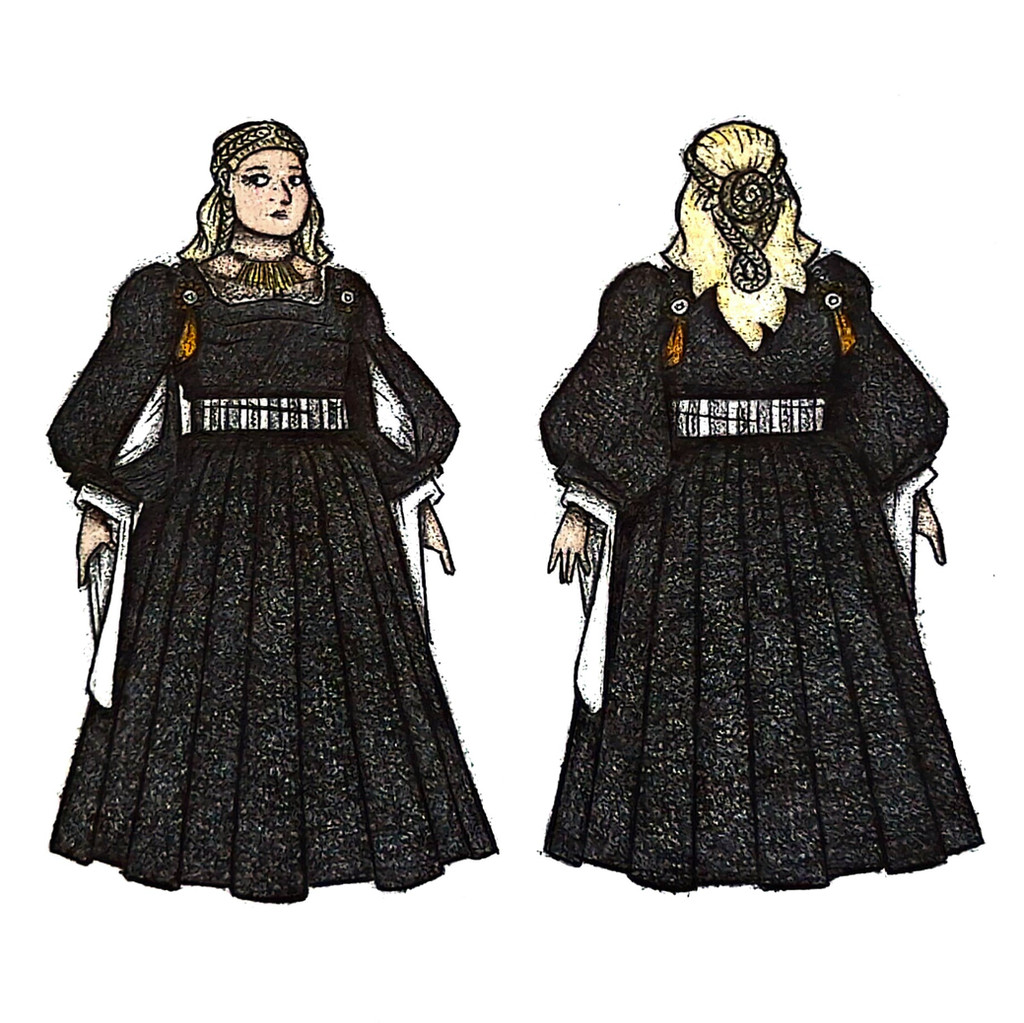HOME | DD
 Avapithecus — Maria di Molino
Avapithecus — Maria di Molino

#character #cyprus #design #history #medieval #referencesheet #renaissance #venetian #buffavento #noblewoman
Published: 2024-05-20 19:14:35 +0000 UTC; Views: 4274; Favourites: 27; Downloads: 0
Redirect to original
Description
This one probably shouldn't count towards this project, but I went down waaaaay too deep a rabbit hole not to harass y'all with my findings.Ok so context: in Assassin's Creed: Bloodlines, one of your targets is a character simply referred to as “the Dark Oracle”, a once-respected noblewoman transformed into a murderous lunatic after being captured by the Templars and imprisoned in Buffavento Castle. I was ready to write this off as just another fanciful character. Afterall, it seems like Armand Bouchart is the only actual historical figure in the entire game. I mean idk, I'm sure it's possible there's a handful of other proper nouns in that Old French Continuation of William of Tyre (the definitive account of this small window of Cypriot history), but I've ranted before about how I can't find a free English translation of this damned book, so I'm in the dark in that regard. As far as I've been able to find, all of the other characters in the game are fictional, some more obviously so than others (I mean come on, Moloch, Shalim, and Shahar? There's only like five Byzantine Greek names and the names of ancient Canaanite gods ain't gonna be among them). Still, I'm a fucking nerd, so I did my due diligence and double checked, and man I'm glad I did because now I've got a whole new thing to rant about.
While I couldn't find any reference to an “oracle” anywhere from medieval Cyprus, my eye was caught by something curious. The Wikipedia article for Buffavento Castle mentions that “a Lusignan period legend claims that the castle was built by a Cypriot noblewoman who was seeking shelter from the Knights Templar in 1191, as such the castle was known as Leonne (Lion's Castle) or Queen's Castle”. I thought well damn okay, that sounds a lot like the backstory of the Dark Oracle given in the game, maybe they actually based her off of something afterall. Now, that one sentence is the only reference the entirety of Wikipedia seems to lend towards this supposed legend, but thankfully they cite a source! They link to "Crusader Castles of Cyprus: The Fortifications of Cyprus Under the Lusignans 1191– 1489", a 2010 thesis by James Petre of the University of Cardiff. So, I downloaded the PDF, scrolled down to the relevant information, and… found similarly little information. Petre just references this legend in passing as some kind of foundation myth which is easily debunked given how the castle predates the Lusignan period. Honestly it's really weird the way he words the sentence cause it sort of implies he mentioned it elsewhere in the paper, but I skimmed through that whole thing and couldn't find any such elaboration. Idk maybe I'm just stupid.
But okay, either way, Petre cites a source of his own: an 1899 book by Camille Enlart called “Gothic Art and the Renaissance in Cyprus”. Cool. I go looking for that book, and there's a readily available English translation online, awesome! Enlart says that even in his day, no one was quite sure where the legend of the noblewoman came from, but he theorizes that it's actually a conflation of two different traditions. On the one hand, there's a character in romantic literature about King Richard the Lionheart often simply referred to as the “Damsel of Cyprus”. The story goes that this was a daughter of Emperor Isaac Komnenos who was taken prisoner alongside her father when the King of England completely wrecked the place. She then proceeded to follow the English wherever Richard went and got involved in whatever wacky Monty-Python-esque bullshit they got themselves into. On the other hand, Enlart cites an incident in 1232 when Eschive of Montbéliard (wife of Balian d'Ibelin) disguised herself as a friar and took refuge from the invading forces of Holy Roman Emperor Frederick II by holding herself up in Buffavento Castle. Now, I don't know about you, but to me that explanation seems a little sloppy. Like, the only throughline all three of these stories have is that they involve a Cypriot noblewoman somewhere somewhen. Yeah Eschive fled to Buffavento Castle, but not from Templars and not in 1191. The Damsel of Cyprus, while closer in time period, seemingly has fuck all to do with Buffavento whatsoever. I'm sure you could roll with Enlart's theory if you really wanted to, like it's not implausible or anything, but there were enough straggling threads there to suggest to me we hadn't quite made it under the hood just yet.
One other detail Enlart mentioned really bugged me in particular. He says that the noblewoman of Buffavento was specifically the foundress of the neighboring St. Chrysostom monastery, who were the actual proprietors of the castle. That may seem like an inconsequential distinction, but trust me that's the sort of minutia that gets every genealogist's panties in a twist. Literally any new proper noun you can add to your search terms can be the key to blowing open an entire chest of informational goodies. Following my hunch, I started looking into this monastery. The oldest church on this site was built circa 1050 CE, dedicated to Saint John Chrysostom, who allegedly blessed a local spring with the power to cure the leprosy of our legendary noblewoman and her dog, hence why she founded the monastery in his name. This myth goes at least as far back as 1745, when it was relayed to pilgrim Richard Pococke by the Venetian monks running the joint at the time. They also told him that their basis for this legend was an old painting sitting behind the church's altar depicting a woman whom they took to be this queen presenting her son to Jesus and the Virgin Mary. This is where everything starts falling into place, and also gets really funny.
See, I'm assuming those monks were Latin-speaking Venetians, because evidently they couldn't read the Greek written on the painting itself straight up describing who it actually depicts. Like sure, it's been worn down after a few centuries, but it was still legible enough that when traveler Ali Bey came to visit the monastery in 1805 and was presented with “da queen”, he found himself in this really awkward moment where he had to break it to the monks that what was clearly written here was “supplication of the servant of God, Maria, wife of Philippe Molino, and Antonio, son of Philippe Molino”. The monks saw no issue with this. “Ohhh”, they said, “well that must've just been the queen's name then”. Sure, that've made no sense given the cultural and political context of 11th century Cyprus but shhhdhdbxnbxkdbvahxjenxhendbshut up. Evidently, this failure of a tourist trap really soured Ali Bey’s mood. He left remarking rather disparagingly, “it is quite certain that when the Palace of the Queen was built, nothing was yet known of Marias or Philippes or Molinos, still less a monastery of St. John Chrysostom”. He was right on the money there. In 1855, Athanasios Sakellarios published a definitive analysis of the artwork in question and the cultural background surrounding the monastery more generally. The real Maria di Molino, it turns out, was not some miraculous 11th century monarch, but rather the wife of a 15th century Venetian rich dude from a family primarily known for trading in wheat and barley. This is probably the only mention of her existence in the entirety of the historical record, and for the longest time they'd just made up a story about a completely different person in a completely different time because they couldn't read her name. That's… kinda sad honestly, but I guess that's the fate of us all eventually.
So okay, let's run through this whole chain of events from the top. Some point in the 15th century (I couldn't even dig up when exactly) a wealthy woman named Maria di Molino donated a large sum of cash to the monastery of St. John Chrysostom. As thanks, the church carves out a little alcove for her and sets up a fancy icon featuring her and her son. The Ottoman period rolls around and new management cycles in. They can't read Greek, so they don't know who this patron was, but they know she was rich and important because of all the shiny stuff associated with her alcove. As such, they assume she was a queen and mistakenly identify her as the founder of the monastery, and that tradition gets repeated uninterrupted until Ali Bey comes to visit in 1805 and actually reads the woman's name, compounded by Sakellarios's analysis in 1855. Despite this, like every tourist attraction, the monks just sort of opt to disregard the Venetian rich lady story because the queen story is just stuck in everyone's heads. At some point between Sakellarios and the arrival of Camille Enlart in 1899, the Knights Templar get added to the story cause I guess if you're gonna stick to pushing an already debunked narrative, you might as well embellish the shit out of it. Enlart takes note of this legend, but he's more here to study the castle, not the monastery, so a note is all it is. Since Enlart seems to be the definitive work on Cypriot castles, this extremely abridged note gets copy pasted in all modern articles about the castles as just a fun fact with no real need for further explanation. Then, it's 2009. Ubisoft is presumably skimming around the early internet for premises to pad out a game set in a time period that has probably all of three paragraphs devoted to it, if that. They stumble across one of these “noblewoman flees Templars at Buffavento in 1191” footnotes in an obscure textbook somewhere and think “oh hey that's perfect, we can work with that!” Out of this very basic premise, they extrapolate the character into the Dark Oracle, then presumably just kinda forgot about Bloodlines like the rest of the fandom, and so it falls to this nerd to go grasping at straws until I find the golden nugget of reality buried in an obscure character of an already obscure game which I have no way to confirm if that was even their intention to begin with or if I've just been way overthinking a total coincidence. I have absolutely no social life.
Design notes, given that entire spiel about how this entire misadventure was caused by a single icon, you'd think this would be relatively straightforward to draw. And okay, in some ways it was. I was able to find some photographs of the wall art in question and take inspiration from there. Unfortunately, those photographs look like they were taken with a potato, which, combined with the already deteriorating condition of the painting itself, doesn't really preserve any of the fine detail I usually enjoy. Maria's dress just kinda looks like a big black blob. There's probably no chance of getting a higher resolution picture either, since apparently the damned thing has since been lost, because of course it has. I blame the British. It's probably sitting in their museum warehouse next to all those human remains and cultural artifacts they're keeping hostage. Oh well, I worked with what I had. One of the articles about the history of this piece mentioned how the dress style is similar to that depicted in Titian's 1512 painting La Schiavona, so I just decided to steal some details from there. It didn't add all that much pizazz, but it was enough. Congratulations, Maria, you now have the distinct honor of having a whole two illustrations of your likeness in the historical record. I don't know you, maybe you were a kind soul or maybe you were a total bitch, but I know you were a human who existed, and hopefully now some more folks out there know that too.
Related content
Comments: 2

👍: 2 ⏩: 1

👍: 2 ⏩: 0
























